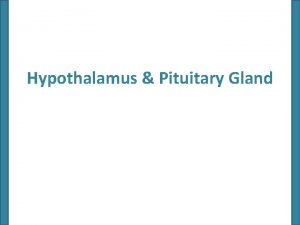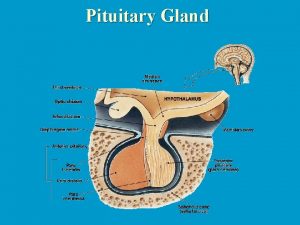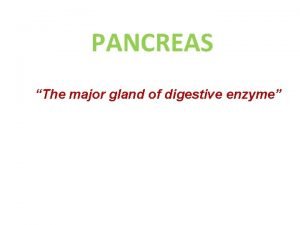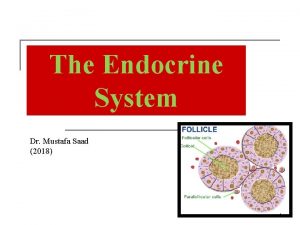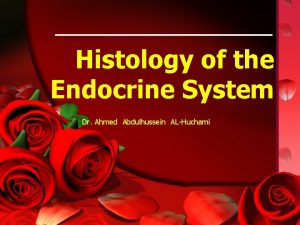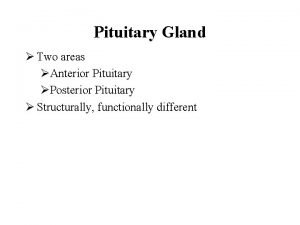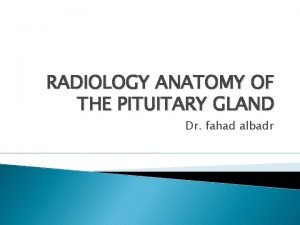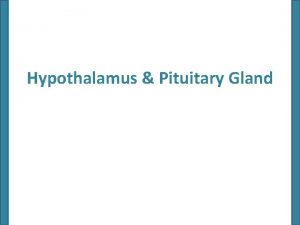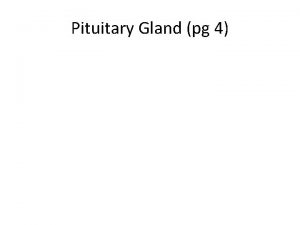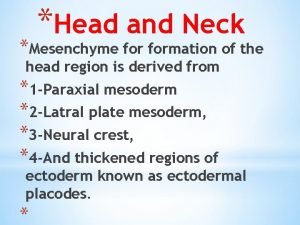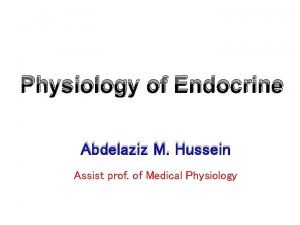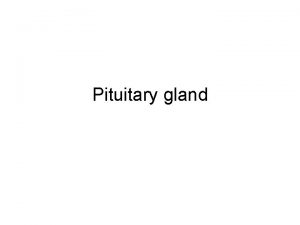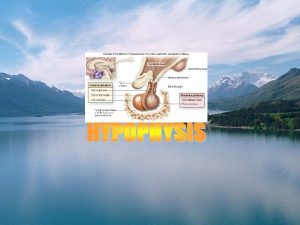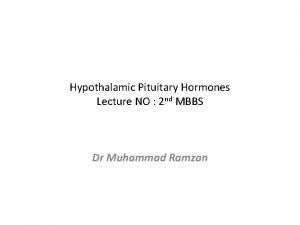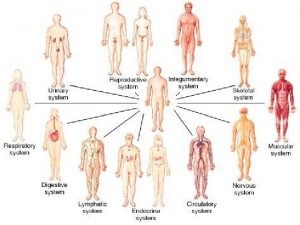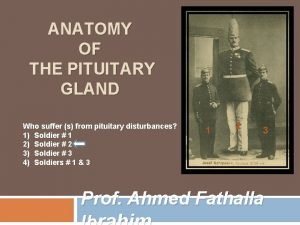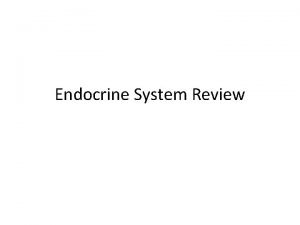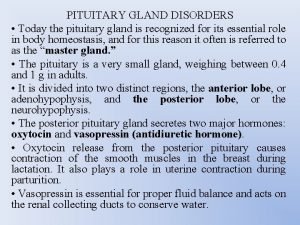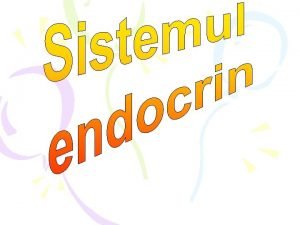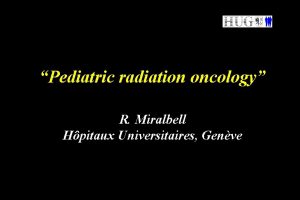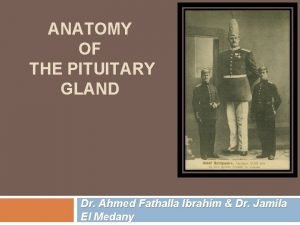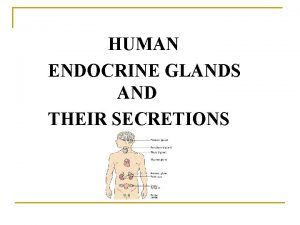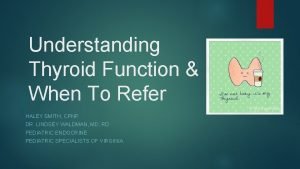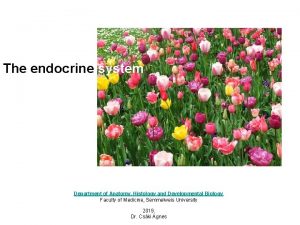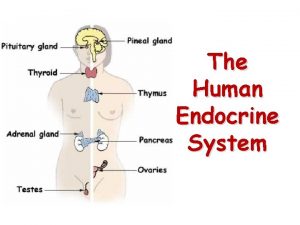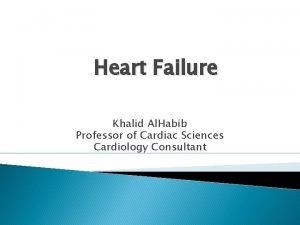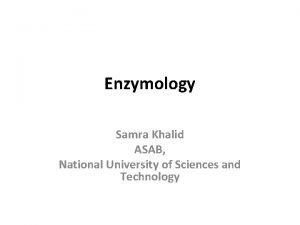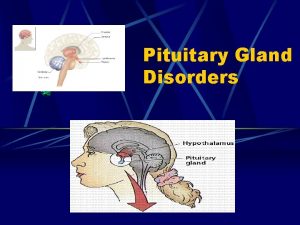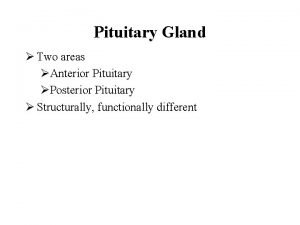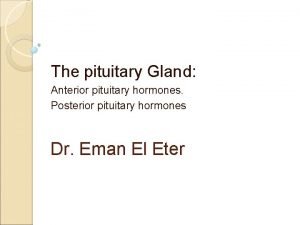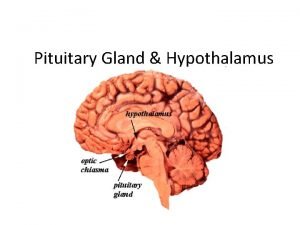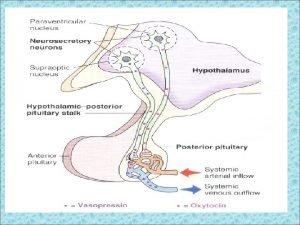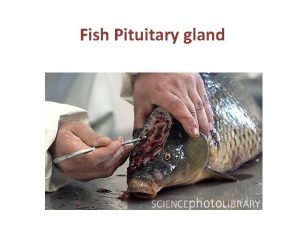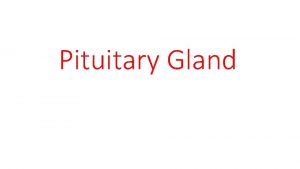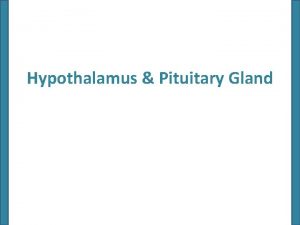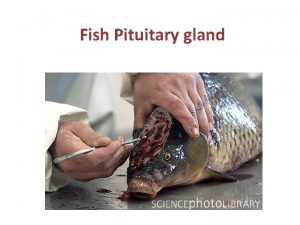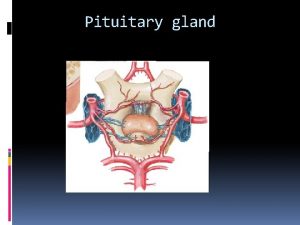The Endocrine Physiology The Pituitary Gland Dr Khalid












































- Slides: 44

The Endocrine Physiology The Pituitary Gland Dr. Khalid Alregaiey

Learning Objectives • List the functional parts (lobes) of the pituitary gland. • Describe the relationships of the hypothalamus to the anterior and posterior pituitary glands. • Describe the hypothalamo-hypophyseal portal system. • Explain the physiological significance of the hypothalamohypophyseal portal system in regulating anterior pituitary functions. • List the hypothalamic hormones and their target cells in the anterior pituitary. • List the anterior pituitary hormones and their target tissues. • Summarize the functions of the anterior pituitary hormones. • Outline the different feedback loops regulating secretion of anterior pituitary hormones. • Summarize the direct and indirect physiological actions of growth hormone. • Outline neuroendocrine control of growth hormone secretion • List stimuli that increase and decrease growth hormone secretion • Describe the role of prolactin in milk secretion. • Discuss regulation of prolactin secretion.

Hypothalamus • hypothalamus is located at the base of the brain. It is part of the limbic system, which controls the autonomic nervous system and the endocrine systems. • One of the most important functions of the hypothalamus is to link the nervous system to the endocrine system via the pituitary gland (hypophysis). • Secretes releasing hormones to cause the pituitary to release hormones • Secretes inhibiting hormones to turn off secretion of pituitary hormones

Three Methods of Hypothalamic Control over the Endocrine System

Hormones of the Hypothalamus HORMONES TARGET stimulates release of TSH and prolactin (PL) stimulates the release of gonadotrophins (FSH, LH) TRH (thyrotropin releasing hormone) Gn. RH (gonadotropin releasing hormone) CRH (corticotropin releasing hormone) stimulates release of ACTH ANTERIOR PITUITARY GHIH (growth hormone release inhibiting hormone GLAND GHRH (growth hormone releasing hormone) or somatostatin (SMS)) PRH (prolactin releasing hormone), also called prolactin releasing factor (PRF) ? PIH (prolactin inhibiting hormone), also called prolactin inhibiting factor. This hormone or factor is dopamine Oxytocin ADH (Vasopresin) FUNCTION stimulates release of GH inhibits release of GH stimulates release of PL inhibits release of PL POSTERIOR PITUITARY GLAND uterine contractions; milk let-down water balance

Pituitary (Hypophysis) • pituitary gland, also called the hypophysis, is a small gland—about 1 cm in diameter and 0. 5 to 1 gram in weight— that lies in the sella turcica, a bony cavity at the base of the brain, and is connected to the hypothalamus by the pituitary (or hypophysial) stalk.

Pituitary (Hypophysis) • Neurohypophysis – posterior lobe (neural tissue) and the infundibulum • Receives, stores, and releases hormones from the hypothalamus • Adenohypophysis – anterior lobe, made up of glandular tissue • Synthesizes and secretes a number of hormones

The Anatomy and Orientation of the Pituitary Gland

Pituitary-Hypothalamic Relationships: Anterior Lobe • The anterior lobe of the pituitary is an outpocketing of the oral mucosa • There is no direct neural contact with the hypothalamus • There is a vascular connection, the hypophyseal portal system,

Hypophyseal portal system • At the median eminence, terminals of hypothalamic neurons release regulatory factors into the tissue fluids then taken by fenestrated capillaries down to the anterior lobe. • Releasing hormones • Inhibiting hormones • All blood entering the portal system will reach the intended target cells before returning to the general circulation

The Hypophyseal Portal System

Pituitary (Hypophysis)

Pituitary-Hypothalamic Relationships: Posterior Lobe • Has a neural connection with the hypothalamus (hypothalamic-hypophyseal tract) • Nuclei of the hypothalamus (supraoptic and paraventricular) synthesize oxytocin and antidiuretic hormone (ADH) • These hormones are transported to the posterior pituitary

Cells Types of the Anterior Pituitary • Five cell types in the anterior pituitary: 1. Somatotropes—human growth hormone (h. GH) 2. Corticotropes—adrenocorticotropin (ACTH) 3. Thyrotropes—thyroid-stimulating hormone (TSH) 4. Gonadotropes—gonadotropic hormones, which include both luteinizing hormone (LH) and folliclestimulating hormone (FSH) 5. Lactotropes—prolactin (PRL)

Adenophypophyseal Hormones • The six hormones of the adenohypophysis: • Are abbreviated as GH, TSH, ACTH, FSH, LH, and PRL • Regulate the activity of other endocrine glands • In addition, pro-opiomelanocortin (POMC): • Has been isolated from the pituitary • Is enzymatically split into ACTH, opiates, and MSH

Adenohypophyseal Cells & Hormones Cell Corticotropes Thyrotropes Gonadotropes Hormone Chemistry Adrenocorticotropic hormone (corticotropin; ACTH) Thyroid-stimulating hormone (thyrotropin; TSH) Follicle-stimulating hormone (FSH) Lutenizing hormone (LH) Physiologic Actions Single chain of 39 amino acids Glycoprotein having two subunits, (89 amino acids) and ß (112 amino acids) Glycoprotein having two subunits, (89 aa) and ß (115 aa) Stimulates production of glucocorticoids androgens by the adrenal cortex; maintains size of zona fasciculata and zona reticularis of cortex Stimulates production of thyroid hormones, T 4 and T 3, by thyroid follicular cells; maintains size of follicular cells Stimulates development of ovarian follicles; regulates spermatogenesis in the testis Causes ovulation and formation of corpus luteum in the ovary; stimulates production of estrogen Glycoprotein having two sub- and progesterone by the ovary; stimulates units, (89 aa) and ß (115 aa) testosterone production by the testis Single chain of 198 amino acids Mammotropes, Lactotropes Prolactin (PRL) Somatotropes Growth hormone Single chain of 191 (somatotropin; GH) amino acids Essential for milk production by lactating mammary gland Stimulates postnatal body growth; stimulates secretion of IGF-1; stimulates triglyceride lipolysis; inhibits actions of insulin on carbohydrate and lipid metabolism

Growth Hormone (GH) • growth hormone (GH) is a protein hormone secreted by somatotropes (somatotrophs), which make up around 40% of the anterior pituitary gland. • GH has many target tissues including bone, skeletal muscle, liver and adipose tissue.

Growth Hormone (GH) • Antagonistic hypothalamic hormones regulate GH • Growth hormone–releasing hormone (GHRH) stimulates GH release • Growth hormone–inhibiting hormone (GHIH) inhibits GH release

Growth hormone promotes growth of many body cells • Promote increased size of the cells • Increased mitosis • Specific differentiation of certain types of cells such as bone growth cells and early muscle cells

Indirect physiological role of GH (GH and growth) Mechanism of action of IGF-1: Increases amino acids uptake by chondrocyres. Stimulates protein synthesis by chondrocyres. Stimulates mitosis of chondrocytes. This effect causes an increase in number of chondrocytes (i. e. , hyperplasia). Stimulates expansion in size of the chondrocytes (i. e. , hypertrophy). Thus, IGF-1 leads to elongation of the bones.

Growth hormone has several metabolic effects 1 - Increased rate of proteins synthesis in most cells of the body 2 - Increased mobilization of fatty acids from adipose tissue, increased free fatty acid in the blood, and increased use of fatty acids for energy. 3 - Decreased rate of glucose utilization through the body

Increased rate of proteins synthesis in most cells of the body (anabolic effect) GH promotes protein deposition in tissues : • enhancement of amino acid transport through the cell membrane • enhancement of RNA translation to cause protein synthesis by the ribosomes • Increased nuclear transcription of DNA to form RNA • Decreased catabolism of protein and amino acids

Increased Mobilization of Fatty Acids • release of fatty acids from adipose tissue • increasing the FFA in the body fluids • conversion of FFA to acetyl coemzyme A • fat is used for energy in preference to the use of carbohydrates and proteins. • High GH levels might cause excessive fat mobilization leading to acetoacetic acid formation by the liver>>> causing ketosis>>>fatty liver.

Decreased rate of glucose utilization through the body (decrease carbohydrate utilization) • Decreased glucose uptake in tissues such as skeletal muscle and fat • Increased glucose production by the liver • increased insulin secretion (cause insulin resistance). • Excess secretion of growth hormone =metabolic disturbances very similar to patients with type II diabetes. (diabetogenic effect)

Necessity of insulin and carbohydrate for the growth promoting action of growth hormone • Animal +lacks of pancreas>>>>no growth hormone effect • Animal+ diet without carbohydrate >>>> no growth hormone effect • Carbohydrate and insulin>>production of energy • Insulin : transport of amino acids into cells and glucose transport stimulation

Growth hormone stimulates cartilage and bone Growth • Increased deposition of protein by the chondrocytic and osteogenic cells that cause bone growth • Increased rate of reproduction of these cells • Converting chondrocytes into osteogenic cells, thus causing deposition of new bone • Strongly stimulates osteoblast activity.

Somatomedins (insulin Like Growth factor-1) • Chondrocytes cultured outside the body+ growth hormone= proliferation or enlargement fails. • Growth hormone +inside body= proliferation and growth of cells

Factors Affecting GH Secretion Stimulation Glucose decrease Free fatty acid decrease Amino acid increase (arginine) Fasting Prolonged caloric deprivation Stress Exercise Puberty Androgens and estrogens Sleep Inhibition Somatostatin Glucose increase Free fatty acid increase IGF-1 Growth hormone Senescence

Metabolic vs. Growth actions of Growth Hormone • Metabolic actions of growth hormone are directly induced by the GH through its receptor. • Growth actions are mediated by insulin-like growth factor 1 (IGF-1)

Metabolic Action of Growth Hormone

Hyposecretion of GH; Dwarfism means failure in growth (i. e. , growth retardation). It is caused usually by defective HGH axis (hypothalamic-anterior pituitaryliver-target organs axis). Thus, dwarfism can be caused by decreased secretion of GHRH, HGH or IGF -I. There may be a defect in the GH receptors. Other causes of dwarfism include deficiency of thyroid hormones in childhood.

Hyposecretion of GH; Dwarfism Normal and abnormal growth

Hypersecretion of HGH Gigantism and acromegaly Excessive production of GH from a GHsecreting pituitary tumour (somatotropes tumours)can cause gigantism if excessive GH production occurs when the body is growing (in childhood and at puberty), i. e. , before the epiphyseal growth plates fuse. Tumors in adulthood (after epiphyseal closure) cause acromegaly.

Pituitary gigantism

Acromegaly Clinical features: Excessive soft tissue growth 1 - prominent supraorbital ridge. 2 - Prognathism. 3 - Ride-spaced teeth (widening of incisor spaces). 4 - Increase shoe size. 5 - Thick spade-like hands 6 - Deepening voice. 7 - Macroglossia. Befor e After

Prolactin (PL) is secreted from mammotrophs (lactotrophs) in the anterior pituitary. Control of PL secretion: • Hypothalamic control of PL secretion is performed primarily by dopamine. Thus, pituitary stalk lesions cause hyperprolacinaemia. • The hypothalamic PRH (prolactin releasing hormone), also called prolactin releasing factor (PRF) stimulates release of PL ? The hypothalamic TRH stimulates release of PL. • PL secretion is increased during pregnancy and suckling. • PL causes increased PIH (dopamine) secretion, i. e. , it inhibits own secretion.

Prolactin (PL) Main target organ: Mammary gland (breast). Effects in females: PL plays an important role in the normal development (growth) of the mammary gland milk synthesis (production) during lactation. PL inhibits Gn. RH, FSH and LH secretion. PL antagonizes the actions of FSH and LH. Thus, ovulation is often inhibited by breast feeding. Effects in males: In males, PL is involved in testicular function.

Effects of PL and control of its secretion

Thyroid Stimulating Hormone (Thyrotropin) • Tropic hormone that stimulates the normal development and secretory activity of the thyroid gland • Triggered by hypothalamic peptide thyrotropinreleasing hormone (TRH) • Rising blood levels of thyroid hormones act on the pituitary and hypothalamus to block the release of TSH

The hypothalamic-pituitary-thyroid axis Thyrotropin releasing hormone (TRH) is produced in the hypothalamus. It reaches the thyrotrophs in the anterior pituitary by the hypothalamic-hypophysialportal system. TRH stimulates the synthesis and release of TSH by the thyrotrophs from the anterior pituitary. In both the hypothalamus and the pituitary, it is primarily T 3 that inhibits TRH and TSH secretion, respectively.

The hypothalamic-pituitary-adrenal axis Corticotropin-releasing hormone or factor (CRH or CRF) is produced in the hypothalamus. It reaches the corticotrophs in the anterior pituitary by the hypothalamichypophysial-portal system. CRH stimulates the synthesis of adrenocorticotrophic hormone (ACTH). ACTH stimulates the synthesis of adrenal steroid hormones. Glucocorticoids (cortisol) released into the systemic circulation exert negative feedback inhibition of CRF and ACTH release from the hypothalamus and pituitary, respectively.

Gonadotropins • Gonadotropins – follicle-stimulating hormone (FSH) and luteinizing hormone (LH) • Regulate the function of the ovaries and testes • FSH stimulates gamete (egg or sperm) production • Absent from the blood in prepubertal boys and girls • Triggered by the hypothalamic gonadotropinreleasing hormone (Gn. RH) during and after puberty

Functions of Gonadotropins • In females • LH works with FSH to cause maturation of the ovarian follicle • LH works alone to trigger ovulation (expulsion of the egg from the follicle) • LH promotes synthesis and release of estrogens and progesterone

Functions of Gonadotropins • In males • LH stimulates interstitial cells of the testes (Leydig cells) to produce testosterone • FSH targets Sertoli cells in the seminiferous tubules of the testes and promotes spermatogenesis
 Pituitary gland and pineal gland spiritual
Pituitary gland and pineal gland spiritual Pineal gland pituitary gland
Pineal gland pituitary gland Hypothalamus and pituitary gland connection
Hypothalamus and pituitary gland connection Amiformes
Amiformes Posterior abdominal wall nerves
Posterior abdominal wall nerves Hypophyseal fossa and pituitary gland
Hypophyseal fossa and pituitary gland Histology of pituitary gland
Histology of pituitary gland Anterior pituitary hormones
Anterior pituitary hormones Anterior pituitary
Anterior pituitary Hypersecretion of prolactin
Hypersecretion of prolactin Cavernous sinus
Cavernous sinus Hypothalamus hormones
Hypothalamus hormones Pituitary gland hormones
Pituitary gland hormones Pituitary gland
Pituitary gland Diaphragma sellae
Diaphragma sellae 30 / 4
30 / 4 Pituitary gland embryonic origin
Pituitary gland embryonic origin Posterior pituitary blood supply
Posterior pituitary blood supply Division of pituitary gland
Division of pituitary gland Pulmon enfermo
Pulmon enfermo Gland
Gland Acromegaly before and after
Acromegaly before and after What is the name
What is the name Pituitary gland disorders
Pituitary gland disorders Blood supply of pituitary gland
Blood supply of pituitary gland Brainstem glioma
Brainstem glioma Pituitary gland nerve supply
Pituitary gland nerve supply N
N Hashitoxicosis
Hashitoxicosis Hypophyseal fossa and pituitary gland
Hypophyseal fossa and pituitary gland Pituitary gland inferior view
Pituitary gland inferior view Estrogen effect
Estrogen effect Physiology of thyroid gland
Physiology of thyroid gland Khalid al habib
Khalid al habib Dr. khalid bazaid
Dr. khalid bazaid Cipralex side effects
Cipralex side effects Your name is ali khalid, isn't it
Your name is ali khalid, isn't it Welcome to the english class images
Welcome to the english class images Dr khalid jamal
Dr khalid jamal Khalid farhan course google drive
Khalid farhan course google drive Nauman khalid md
Nauman khalid md Dr bhanu deval
Dr bhanu deval Samra khalid
Samra khalid 911 in roman numerals
911 in roman numerals Khalid alsadhan
Khalid alsadhan


